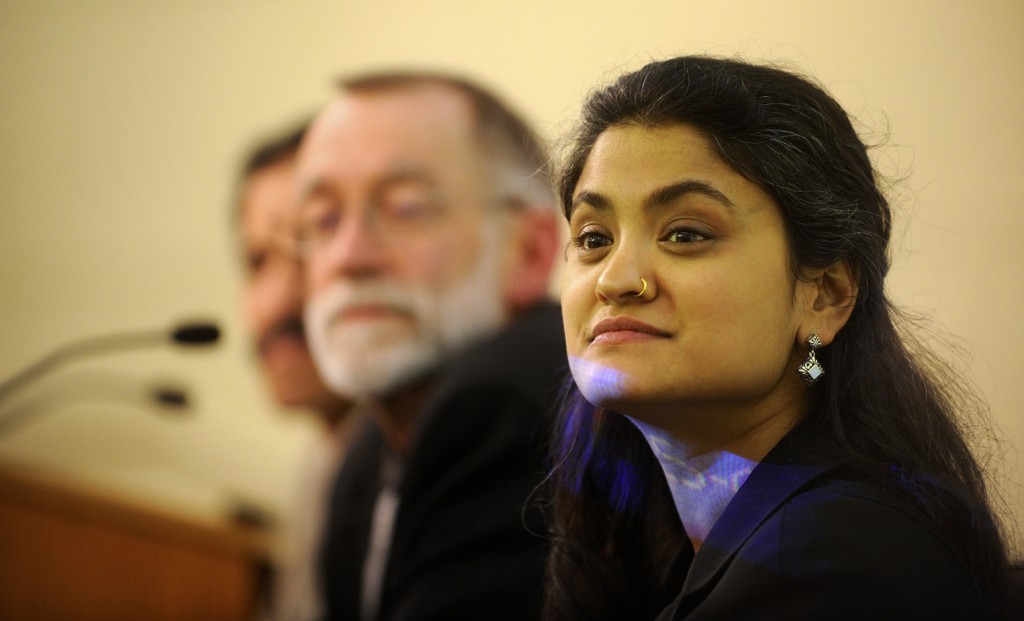Sujatha Baliga, who was featured in the New York Times Magazine (Jan. 4, 2013) for her role as a restorative justice practitioner in a Florida murder case, offered an insider’s candid views on the now-famous case in a 90-minute webinar hosted by Eastern Mennonite University’s (EMU) Howard Zehr on Jan 30, 2013.
Among the 90 webinar viewers were the parents of the murder victim, Ann Grosmaire, who was shot on March 28, 2010. The parents of the boyfriend who shot Ann, Conor McBride, also tuned into the webinar. At the time of Ann’s death she was 19 and he was 20, and both sets of parents were fond of the other young person.
In addition to those from the United States, participants in the webinar logged in from Australia, Canada, Estonia, the United Kingdom, and Vatican City.
Baliga stressed repeatedly during the webinar that the Times headline “Can Forgiveness Play a Role in Criminal Justice?” mistakenly conflated forgiveness with restorative justice when actually, “forgiveness is never a prerequisite for participation in a restorative process, nor is it an expected outcome of any restorative process, ever.”
Baliga, a lawyer who directs the Restorative Justice Project at the National Council on Crime and Delinquency, noted, however, that the love, remorse, responsibility taken and forgiveness seen in this murder case made it highly unusual.
She came into the case after the mother of Conor, Julie McBride, did an Internet search for an expert on restorative justice, located Zehr at EMU and contacted him. Zehr recommended Baliga.
For a restorative justice conference desired by both sets of parents, Baliga convened, among others, the assistant state attorney in charge of prosecuting the crime, the defense attorney, the four parents, and Conor himself. The conference was held in the jail holding Conor.
The conference yielded something much different than the usual death penalty or life sentence in such cases in Florida. It resulted in a plea for a 20-year sentence, plus 10 years of probation, for Conor, which the court accepted. The conference proved to be a step towards healing and a sense of peace for the family members.
Typing into a chat forum, webinar viewers submitted comments and questions to Zehr, who read them to Baliga for answering. The Grosmaires commented, “Christian forgiveness does not require reconciliation. It would be the ultimate goal but it requires both parties to participate. The offender must repent and work to not harm the other person. This isn’t possible in every case.”
A prosecutor who said he works in South Africa typed that he has just been assigned to do restorative justice work, as did a second prosecuting attorney, presumably from the United States. Baliga and Zehr were clearly pleased at the idea that some prosecutors might be shifting to a restorative approach, with its focus on meeting the needs of those touched by a crime.
In the webinar, Baliga repeatedly credited Zehr for his behind-the-scenes role in advising her as she waded into this unprecedented case. She encouraged viewers to read “everything Howard has ever written” and to seek the best possible training in restorative justice, citing two women who regularly teach as guest instructors at EMU’s Center for Justice and Peacebuilding: Lorraine Stutzman Amstutz, author of The Little Book of Victim Offender Conferencing, and Kay Pranis, author of The Little Book of Circle Processes.
The Jan. 30 webinar was an initiative of the newly founded Zehr Institute for Restorative Justice at EMU. Zehr, Baliga, and the Grosmaires will be appearing on a panel to discuss the case tentatively scheduled for March 14-15, at Campbell University School of Law in Buies Creek, North Carolina.
The 90-minute webinar is available through the restorative justice blog.
